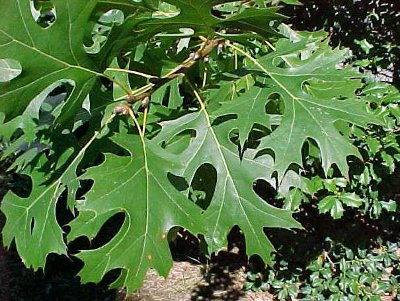Shumard Oak Tree
Category: Deciduous Trees

Facts about Shumard Oak Tree, "Scientific name for Shumard Oak Tree is Quercus shumardii". The Shumard oak tree is native to northern Florida, central Texas and North Carolina and it is also known as Quercus shumardii or the spotted oak, Shumard red oak or the Schneck oak tree. It is known to be the largest among the red oak family with a maximum height of up to approximately fifty five to eighty feet (16.76 to 24.38 meters) and a trunk spread of twenty four to thirty nine inches (60.9 to 99 cm). The Shumard Oak Tree grows in to a large oak with a rounded, narrow, open crown which can be about thirty nine to fifty nine feet wide and twelve to eighteen meters long.
The Shumard Oak Tree exhibits a shiny, smooth, gray colored bark at its early stages of growth and matures to become furrowed, deeply-ridged, and dark in color with occasional white splotches. The Shumard Oak Tree’s olive-green branching develops to end into clusters of buds with a lighter color. Shumard Oak Trees leaves are wide, obviate in shape and have an alternate arrangement of five to nine bristle- tipped lobes on individual clusters. It leaves can grow four to eight inches (10.1 to 20.3 cm) in length with a dark green color above and a paler hade of green underneath. Its leaves usually turn brown to red and sometimes with hues of yellow during fall. The leaves give way to fruits, acorns which have a spread of one inch (2.5 cm) and can take up to three years to mature.
Shumard Oak Tree leaves are made up of many colored pigments, green chlorophyll hides the colors during the growing season of spring and summer. As days get shorter and cooler temperatures come in the fall, it cause the chlorophyll to break down and than the other color pigments can be seen.
Shumard Oak Tree growth is referred to as Meristem (The undifferentiated embryonic plant tissue from which new cells are created, as that at the tip of a root or stem). This tissue can be found at the tips of shoots and leaves. Inside the stem growth in thickness occurs at the vascular cambium.
Shumard Oak Trees make their own food from sunlight, carbon dioxide, water, and nutrients from the soil.
The Shumard oak tree can grow well in occasionally wet to well-drained soils and in partial to full sun. It can do well in several soil conditions including various ranges of soil pH and it's also highly tolerant to drought.
A Full grown Shumard Oak Tree can absorb as much as 48 pounds (21.77 kg) of carbon dioxide a year. The same Shumard Oak Tree could also produce enough oxygen in a day for two people. In a single day, a large Shumard Oak Tree can drink up to 100 gallons (378.5 liter) of water from the ground and discharge it into the air.
You can tell a Shumard Oak Trees age by the number of growth rings. Growth rings size shows what kind of conditions accrued that year, the temperature and if it was a dry or wet year.
Bark of the Shumard Oak Tree protects it from the elements and is made up of dead cells.
The Shumard Oak Tree fruits, acorns, are food for various wild birds and animals including waterfowls, feral hogs, squirrels and white-tail deer. The Shumard Oak Tree can also be used in furniture, flooring, paneling, and decorative modeling and also as a shade tree. This tree can be found in zones 8 and 9.
Shumard Oak Tree roots usually grow two to three times the width of the tree branches. The ideal time to fertilize your Shumard Oak Tree is in late fall or early spring. If you want to transplant a Shumard Oak Tree do it in fall, this is ideal for most trees.

 Back To Category Deciduous Trees
Back To Category Deciduous Trees